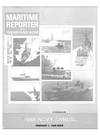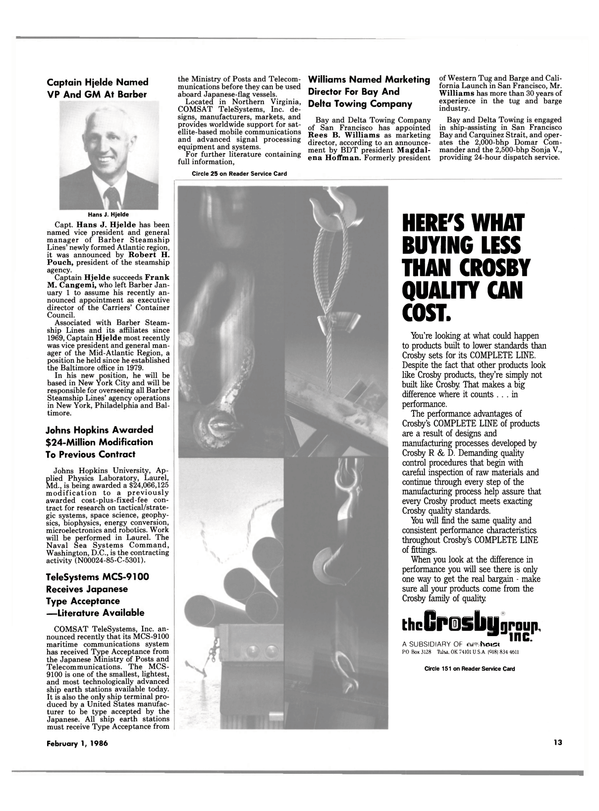
Water Jetting System To Install Steel Pilings Developed By Navy
The U.S. Navy is developing a unique universal footing that uses a novel internal water jetting system to install steel foundation pilings in all types of seafloors, more quickly and more economically than present methods.
The Naval Civil Engineering Laboratory (NCEL) at Port Hueneme, Calif., designed the new concept primarily for the Navy's Advanced Cargo Transfer Facility (ACTF), under construction at the research and development center. Supported by a series of pilings placed into the seafloor, the ACTF will extend more than 2,500 feet from the shore into the ocean, to containerships berthed in water depths of 50-60 feet. Cargo will be unloaded directly for transfer across the facility to storage areas ashore.
The ACTF poses installation problems because installers did not have the luxury of changing or modifying footings. The NCEL universal footing system provides a onefoundation capability for all seafloors— clay, silt, sand, gravel, coral, and rock. The system consists of three parts: spike, spud can, and an internal jetting element. The coneshaped spike supports the structural weight when the footing is deployed into the rock or coral seafloors.
Made of high-strength steel, the spike also guards against sliding.
The spud can is an enlarged footing base that supports the piling in soft sediment (mud, silt, and sand) and reduces the required pile length. When embedded, the spud can provides major resistance against sliding, bearing failure, and pullout.
The internal jetting system fluidizes (suspends and hangs in water) the soil around the footing. This action allows the footing to move downward through the sediments until it is buried by its own weight.
If the footing is placed on a sand or silt seafloor, the downward jetting of water will fluidize the sediments and induct footing penetration.
Both upward and downward jets may be activated for retrieval of the footing.
Dr. Sheng S. Lin, a senior civil engineer at the NCEL and developer of the concept, said the system features 20 nozzles—16 holes in the bottom of the spud and four on the spike. Tests of a model footing (photo) reveal that the universal footing can be buried by its own weight. At a water pressure of 60 psi and flow rate of 60 gpm, the footing can penetrate soft sediments at two feet per minute. It takes 12 minutes to gain equal penetration with a jet flow rate of 35 gpm. Pullout forces of the footing decrease from 1,200 pounds without jetting to 200 pounds with 60 gpm.
Read Water Jetting System To Install Steel Pilings Developed By Navy in Pdf, Flash or Html5 edition of February 1986 Maritime Reporter
Other stories from February 1986 issue
Content
- Bremer Vulkan To Build 2 Bremen Class Frigates For Federal German Navy page: 5
- Study To Evaluate Tanker-Based FPSO For Gulf Of Mexico page: 5
- Marinette Marine Delivers Last Of 52 Workboats A Year Ahead Of Schedule page: 6
- Boston Fuel Acquire Assets Of Boston Towboat Co. page: 7
- M.A.N.-GHH To Build Floating Drydock For Polish Shipyard page: 7
- British Broker Reports Surge In Tanker Rates, Fall In Laid-Up Tonnage page: 7
- Robert E. Derecktor Launches First Of Two Staten Island Ferries page: 8
- Beth-Sparrows Point Yard Installs $1.1-Million Intermediate Gate For Building/Vessel Servicing Basin page: 8
- New Names Announced For Wartsila Diesel Units page: 9
- HIAB-FOCO Delivers Two Service Cranes To North Sea Oil Project page: 9
- Bath Iron Works Launches Its First Aegis Cruiser page: 10
- Water Jetting System To Install Steel Pilings Developed By Navy page: 11
- USCG And ASNE Flagship Section Sponsor Patrol Boat Symposium page: 12
- Webber Appointed Vice Admiral And U.S. Navy's Chief Engineer page: 12
- Automatic Power Offers 20-Page Color Brochure On Marine Signal Systems page: 12
- Captain Hjelde Named VP And GM At Barber page: 13
- TeleSystems MCS-9100 Receives Japanese Type Acceptance page: 13
- IS IT TIME TO TAKE THE PUBLIC SHIPYARDS PRIVATE? page: 16
- UPDATE ON FY 1986 NAVY PROGRAMS page: 26
- Navy Contracts Totaling $629.2 Million Awarded To Bath And Ingalls Yards page: 30
- Peterson Builders Delivers ARS-51, Grasp, To Navy page: 31
- 1986 Apelco Full-Color Product Catalog Available page: 34
- Carnegie Hero Medals Awarded Posthumously To Fournier, Govoni page: 34
- Coast Guard And Navy To Hold Joint Fire Research Program page: 35
- Peterson Builders Receives Navy Certification Of Metal Spray Facility page: 35
- Key Appointments At Oerlikon page: 36
- NICOR Consolidates Administrative Functions Of 2 Marine Subsidiaries page: 36
- BP Offers Free 32-Page Brochure On World Energy page: 37
- ASEA Names Jon Turley Manager Marine Offshore page: 37
- New One-Stop Shopping Sensors And Controls Catalog From Transamerica Delaval page: 38
- Marine Machinery Association To Sponsor Navy/Industry Panel Discussions On Feb. 26 page: 38
- The New 710G Series Diesel Engines From General Motors Electro-Motive Division page: 40
- Todd Ceases Operations At New Orleans Division page: 41
- Marine Travelift Introduces New Floating Boat Hoist Design page: 41
- Puroflow Filters To Protect Sperry Computers page: 42
- Texas Instruments Offers New GPS Software page: 43
- Aegis Missle Cruiser Valley Forge Commissioned At Ingalls Yard page: 44
- New Yard Opens In Port of Altamira page: 47
- Jacques Cousteau Receives Testimonial Plaque From Carrier Transicold Employees page: 47
- Vecom Takes Over Marine Division Of Houseman page: 48
- Caterpillar Offers Literature On New Marine Diesel Propulsion System Products And Support Programs page: 49
- New Teleflex Remote Valve Actuators Are Designed To Eliminate Problems And Cut Costs page: 52
- Dr. A.C. Antoniou Joins ASRY Production Team page: 53
- Dillingham Offers Free Full-Color Brochure On Ship Repair Facilities page: 53
- Hempel Introduces 'Damp Steel' Primer page: 54
- Reco Crane Promotes Hardin—Literature Offered page: 60
- Metropolitan Offers New Vanstone Flanged Fittings page: 60
- Meyer Retires As Deputy Commander At NAVSEA page: 60
- American Appoints Monaco New Cordage Engineer page: 61


